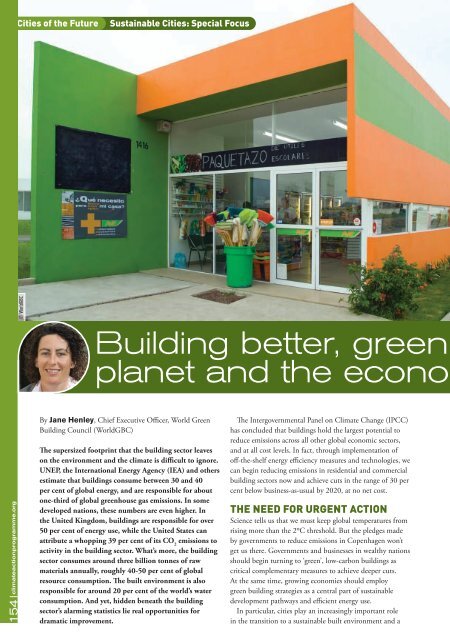Climate Action 2011-2012
You also want an ePaper? Increase the reach of your titles
YUMPU automatically turns print PDFs into web optimized ePapers that Google loves.
cities of the future<br />
Sustainable cities: Special focus<br />
© WorldGBC<br />
Building better, green<br />
planet and the econo<br />
154 climateactionprogramme.org<br />
By Jane Henley, Chief Executive Officer, World Green<br />
Building Council (WorldGBC)<br />
The supersized footprint that the building sector leaves<br />
on the environment and the climate is difficult to ignore.<br />
UNEP, the International Energy Agency (IEA) and others<br />
estimate that buildings consume between 30 and 40<br />
per cent of global energy, and are responsible for about<br />
one-third of global greenhouse gas emissions. In some<br />
developed nations, these numbers are even higher. In<br />
the United Kingdom, buildings are responsible for over<br />
50 per cent of energy use, while the United States can<br />
attribute a whopping 39 per cent of its CO 2<br />
emissions to<br />
activity in the building sector. What’s more, the building<br />
sector consumes around three billion tonnes of raw<br />
materials annually, roughly 40-50 per cent of global<br />
resource consumption. The built environment is also<br />
responsible for around 20 per cent of the world’s water<br />
consumption. And yet, hidden beneath the building<br />
sector’s alarming statistics lie real opportunities for<br />
dramatic improvement.<br />
The Intergovernmental Panel on <strong>Climate</strong> Change (IPCC)<br />
has concluded that buildings hold the largest potential to<br />
reduce emissions across all other global economic sectors,<br />
and at all cost levels. In fact, through implementation of<br />
off-the-shelf energy efficiency measures and technologies, we<br />
can begin reducing emissions in residential and commercial<br />
building sectors now and achieve cuts in the range of 30 per<br />
cent below business-as-usual by 2020, at no net cost.<br />
The need for urgenT acTion<br />
Science tells us that we must keep global temperatures from<br />
rising more than the 2ºC threshold. But the pledges made<br />
by governments to reduce emissions in Copenhagen won’t<br />
get us there. Governments and businesses in wealthy nations<br />
should begin turning to ‘green’, low-carbon buildings as<br />
critical complementary measures to achieve deeper cuts.<br />
At the same time, growing economies should employ<br />
green building strategies as a central part of sustainable<br />
development pathways and efficient energy use.<br />
In particular, cities play an increasingly important role<br />
in the transition to a sustainable built environment and a












